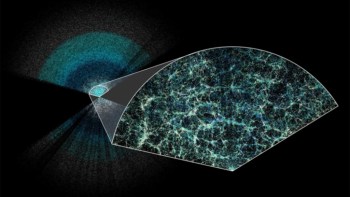Evidence for dark matter is growing, and so are our chances of directly detecting it

It may come as a surprise to many people but 95% of what makes up the universe is still a mystery to scientists. Until very recently, however, we had devoted at least that proportion of our effort to understanding the remaining 5% – the small fraction that seems to be made up of ordinary baryonic matter such as atoms.
But most cosmologists now agree that there is five times as much “dark matter” as ordinary matter. Moreover, the remaining 70% of the universe is thought to consist of an even more mysterious entity called dark energy, which is causing the universe to expand ever more rapidly.
Dark matter may be invisible but it ranks among the hottest topics in modern physics. Without it, we cannot explain the gravitational pull that holds galaxies and clusters of galaxies together when they clearly have insufficient mass in the form of stars. This mass discrepancy was noted as long ago as the 1930s, but it is only in the last few years that precision observations of the cosmic microwave background, combined with other cosmological measurements, have allowed physicists to determine the abundance of dark matter more precisely.
Missing baryons
Although much attention has recently been given to dark matter and dark energy, astronomers have not forgotten that as much as half of the ordinary matter in the universe was unaccounted for until recently. Only 10% of baryons appeared to be luminous matter in the form of stars, and no more than 40% could be identified as gas in galaxy clusters and as intergalactic hydrogen.
Earlier this year, however, Fabrizio Nicastro and colleagues at the Harvard-Smithsonian Center for Astrophysics, Ohio State University, the University of California at Berkeley, UNAM in Mexico and the Massachusetts Institute of Technology found these missing baryons at cosmological distances using the space-based Chandra telescope (Nature 433 495).
The baryons were betrayed by telltale atomic absorption lines imprinted against the X-ray spectrum of a distant background object called the Markarian 421 blazar. Nicastro and co-workers found very hot but low-density filaments of gas containing carbon, nitrogen and oxygen, and which were spread across the vast expanses of intergalactic space. Even though the baryon densities in these filaments are at best only about one-millionth of those in the interstellar medium between the stars in our galaxy, the Milky Way, they can still account for half of all the baryons in the universe.
Furthermore, the team suggests that the total baryon content of the universe may well be slightly higher than astronomers had originally thought. However, rather than challenge the standard “concordance” model of cosmology, the filament structure of this hot gas actually agrees with the clumpy distribution of matter predicted in a universe dominated by cold dark matter.
So, what about the non-baryonic, dark-matter content of the universe? Recent astrophysical data support the idea that dark matter may be made of as yet undetected weakly interacting massive particles (WIMPs). Created shortly after the Big Bang, these particles are predicted to interact very little with the ordinary matter in today’s universe, although they are expected to experience similar gravitational forces. WIMPs may be heavier than the largest stable atoms, and we think that they might float about in halos around galaxies, including our own. On larger, cosmological scales they may have assembled into larger structures alongside the luminous matter.
As well as providing a possible explanation for dark matter, the discovery of WIMPs would revolutionize our understanding of fundamental particles. This is because supersymmetry – a popular theory to explain phenomena beyond the Standard Model of particle physics – predicts the existence of a particle called the neutralino, which has just the right mass and interactions to account for the invisible matter in the universe. The mere prospect of such a natural WIMP candidate – albeit only a theoretical one – has led many physicists to believe that this may be more than just coincidence.
Detecting the invisible
Earlier this year, an international team led by astronomers at Cardiff University in the UK announced the discovery of what could be the first dark galaxy ever detected. The object, which lies some 50 million light-years away in the Virgo cluster, was first spotted in 2004 when astronomers detected radio emissions from hydrogen gas with the Lovell radio telescope at Jodrell Bank Observatory. But Robert Minchin and colleagues at Cardiff, together with co-workers in Italy, France and Australia, have now studied VIRGOHI21, as it is known, in much more detail (Astrophys. J. 622 L21-24).
The newly discovered galaxy consists of a rotating disk of atomic hydrogen, but it does not appear to contain a visible stellar counterpart. The rotational speed of the galaxy suggests that it contains enough mass for its stars to be fairly easy to observe. Indeed, Minchin and co-workers calculate that VIRGOHI21 is 1000 times more massive than can be accounted for by the amount of hydrogen detected. The only way to explain why this system remains gravitationally bound seems to be that it contains a large dark-matter component.
This is initially surprising, given that the average abundance of non-baryonic matter in the universe is only about five times that of ordinary matter. However, computer simulations do indeed predict that there are more dark-matter halos than visible galaxies, suggesting that star-less galaxies such as VIRGOHI21 could exist. More such findings are therefore eagerly awaited!
Another way to search for dark matter is to look for signatures of its interactions with ordinary matter and also with itself. For instance, WIMPs are expected to annihilate with one another to produce known particles, including gamma rays. If they also succumb to gravity and fall into galactic centres, then this is where we would expect to see more of this self-annihilation occurring.
Observations with the INTEGRAL space telescope have recently confirmed an excess of gamma rays with a characteristic energy of 511 keV coming from the centre of the Milky Way. This is a clear signature of positrons annihilating with electrons, but raises the controversial issue of how so many low-energy positrons come to be near the galactic centre in the first place.
In 2004 Céline Boehm and Dan Hooper of Oxford University and co-workers suggested that the annihilation of a light dark-matter particle could account quite simply for the excess of positrons and the 511 keV emission, albeit by resorting to more exotic physics than other astrophysical explanations (Phys. Rev. Lett. 92 101301). Considerably lighter than typical WIMPs, the dark-matter scenario based on these particles was received with apprehension by those of us involved in Earth-based direct-detection experiments. Such a flimsy particle would stand little chance of being registered with current detector technology, and accelerator experiments might only be able to infer its existence indirectly.
At the other end of the mass scale, a case for the annihilation of very heavy WIMPs near the centre of our galaxy is being made by Dieter Horns of the Max Planck Institute for Nuclear Physics in Heidelberg (Phys. Lett. B 607 225). This follows the detection of very high-energy (TeV) gamma rays by HESS and other atmospheric Cerenkov telescopes last year. A very heavy neutralino would be required to explain these results, and some other type of WIMP would probably have to be considered as well.
Meanwhile, measurements of the cosmic microwave background made by WMAP may provide unlikely support for a more typical, supersymmetric neutralino. Since all microwave foregrounds from known sources must be removed to retrieve the cosmological data, great care is taken to map galactic signals accurately.
Last year, while working on subtracting these foreground sources, Douglas Finkbeiner of Princeton University found an excess of microwaves from the galactic centre not accounted for by any other foreground signal. He cautiously termed this the “WMAP haze” and proposed that it could be due to the self-annihilation of neutralinos into relativistic electrons and positrons.
Moving through the galactic magnetic fields with such enormous velocities, these particles would then emit synchrotron radiation with a frequency spectrum much like that now observed from the galactic centre. Furthermore, they might also be interacting with photons from the microwave background and from stars, shifting them to much higher energies and perhaps even explaining some of the high-energy gamma-ray results in the process.
Support for the supersymmetric neutralino is also emerging from the extragalactic gamma-ray background – a flux of high-energy gamma rays that bombards the Earth from all directions. It has been known for some time that the extragalactic spectrum exhibits a bump at high energies. However, based on a re-analysis of data from the Compton observatory, Dominik Elsasser and Karl Mannheim of the University of Würzburg in Germany have argued that this bump may be due to the annihilation of WIMPs in nearby regions of the universe (arXiv.org/abs/astro-ph/0405235). They propose that a typical neutralino can reconcile the data better than more traditional astrophysical sources such as blazers.
Going underground
Eventually, WIMPs will have to be caught in a more down-to-Earth environment before we have definitive proof of their existence. However, while we may come to create them in a controlled way in future accelerators such as the Large Hadron Collider at CERN, demonstrating the existence of a particle with the right mass does not in itself solve the dark-matter problem: we also need to find out if there are enough of them out there. Therefore, nothing can replace a direct detection in the laboratory.
Several experiments worldwide are currently involved in this very competitive search, with most of them looking for the small and extremely rare nuclear recoils that are expected to occur when a WIMP hits an ordinary atom in a detector target. Shielding the detectors from ubiquitous cosmic rays has moved this search to sites deep underground. Currently, the most sensitive experiment is the Cryogenic Dark Matter Search (CDMS II) running in the Soudan underground laboratory in the US (see Physics World June 2004 p6). The absence so far of neutralino-like events in CDMS II excludes previous results obtained by the Italian-Chinese DAMA collaboration, which for several years has claimed to have detected dark matter based on an annual modulation signal observed in scintillator crystals.
Several groups in the UK are involved in direct searches using different detector technologies, including three advanced WIMP detectors that are being commissioned by the UK Dark Matter Collaboration for use in the Boulby mine in North Yorkshire. Two of these – known as the ZEPLIN programme – use liquid xenon as a target, and will achieve record sensitivities that will allow us to probe deep into the parameter space favoured by supersymmetry. The third system, part of the DRIFT programme, is designed to obtain directional information on WIMP interactions in a gas.
Even if these and other detectors being deployed across the world miss the first WIMP sighting, valuable upper limits are being placed on the allowed interaction rates with ordinary matter. And because it has invested in scalable detector technologies, the UK is well positioned to lead a much more ambitious generation of experiments containing targets weighing up to a tonne. In a few years these systems would be able to tell once and for all whether WIMPs are indeed the answer to the dark-matter problem, or whether nature has reserved yet more surprises for us.




